History
The Early Days
Beckminster Church can be said to trace its roots back over 270 years to when it is known that Methodist preachers visited Wolverhampton, at least as early as the 1740’s. William Allt visited the town in February 1745, and George Whitefield preached here on 26th October 1753.
John Wesley first visited the town in March 1760 and addressed a crowd from the steps of a shop in High Green (now Queen Square) and again a year later when he preached in the yard of the Swan Inn, Dudley Street.
The First Chapel
The first organised services in Wolverhampton were held in an improvised chapel in Rotten Row, in the vicinity now covered by Broad Street and Canal Street
The Old Meeting House
Such was the popularity of Methodism that the original chapel was not adequate for the needs of the Society. The Old Meeting House in John Street, which had been built by a society of Protestant Dissenters in 1701 was used as a chapel of ease. The Rev J Stubbs, a Calvinist and Trinitarian, was its first minister.
Noah’s Ark Chapel
In 1787 a new chapel some 12 metres long by 10 metres wide, containing a gallery, family pews and free seating on either side, was erected behind the ‘Noah’s Ark’ Inn (now called ‘The Posada’) in Lichfield Street and was opened by John Wesley on 28th March of that year. By 1908 it was necessary to acquire further temporary premises in John Street to act as an extension to the Ark.
Darlington Street Chapel
By the early 1820’s, even with the John Street extension, the Noah’s Ark chapel had become too small for the increasing congregation and the elders decided that a new, all purpose chapel be built on a site at the corner of School Street and Darlington Street. The original Darlington Street chapel was built on a site purchased from the Earl of Darlington for £395 and was completed in 1825.
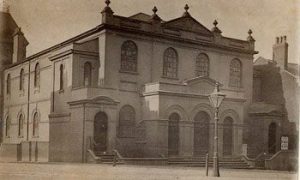
Darlington Street Chapel 1825
Trinity Church
In 1862 Mrs G. B. Thorneycroft, the first Lady Mayoress of Wolverhampton, conceived the idea of a new church on Compton Road and along with her son-in-law John Hartley (a former Mayor and later County High Sheriff) donated the site and £1000. John Hartley’s nephew Henry Hartley Fowler (who became the first Methodist Cabinet Minister and later Lord Wolverhampton) gave £500. Because of their love of the beauty and dignity of the Anglican Service, they insisted that their Church should use John Wesley’s form of that Service at morning worship.
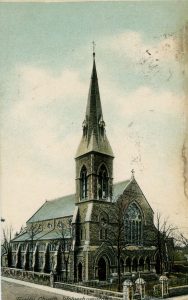
Early postcard showing Trinity Church
The Penn Road Chapel
Sometime in the 1870’s or earlier a group of young men began preaching outdoors in Poutney Street. They met with considerable success and after a while it was found necessary to provide a sheltered place of worship from which to provide mutual support for those who were interested and a base for their continued Christian mission. To this end a wooden building was erected, described on the Circuit plan of the time as ‘Bloomsbury’ but called by the general populace as ‘The Salt Box’. Records report that although there was nothing pretentious about the room conversions were frequent, a good Sunday school was formed and a lively Society class was formed, initially under the leadership of a Mr T. Perks and later of Mr John Ward and Mr T. Moreton. Until Trinity was built the whole of Wolverhampton was included in the Darlington Street Circuit, but in 1888 a second Circuit was formed with Trinity at its head.
The ‘Salt Box’ was not an ideal place for worship; it was hot in summer, cold in winter and open to the rain in wet weather so they began to think of something better and began to raise money for the building of a new chapel. A Mr David North donated a new site in Mander Street, valued at £420, and also contributed liberally to the cost of the building work. The new chapel, which eventually cost £1,920, was opened for worship in 1878.
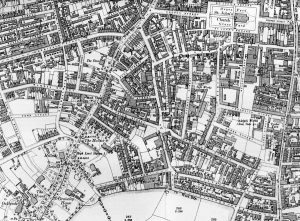
1903 map showing location of site
Soon after moving to the new premises however there arose a general feeling that the spiritual state of the Church had declined since leaving the old hut and steps needed to be taken to redress the matter. Members were called together to discuss a plan of action and amongst other measures it was decided to hold regular prayer meetings and local preachers were invited to preach on weeknights. The changes worked and with the renewal of the spiritual life of the Church any previous difficulties vanished. A new vestry was built and land between the chapel and Penn Road, used as a builders yard, was acquired; it was cleared, fenced and an entrance to the chapel from Penn Road provided.
Methodism Comes to Bradmore
From 1883 onwards the Penn Road Chapel began to organise cottage meetings in the village of Bradmore and these meetings flourished to such an extent that in 1888 the Wesley Guild of Trinity Church formed a Bradmore sub-committee to take responsibility for running them. Led by the Trinity Sunday School Superintendent, a Mr Bernard Williams, the average age of the committee members was just 19 years, yet they took over complete control of the work at Bradmore, either by taking the Services themselves or by inviting other speakers.
A number of names are mentioned in allowing their homes to be used for these early meetings, Mrs W. Wellings, Miss Ann Wellings. William Inscoe, and a Mr and Mrs Griffiths. The first of these was almost certainly Mary Ann Wellings who lived with her husband William, a carpenter, at ‘Grendon’ in Broad Lane. Miss Ann Wellings lived in an unnumbered cottage in Seisdon Lane (later re-named ‘Trysull Road’).
The Old Smithy
By 1897 it had become obvious that there was a need for larger premises and a disused blacksmith’s premises located on what is now the car park of the ‘Hungry Horse’ public house at Bradmore was purchased. A band of enthusiastic workers led by Ernest Wright, William Wellings, his brother Thomas and Charles Yale stripped out the two smith’s hearths, laid down a floor, put in a new ceiling, widows and doors and cleaned and decorated the old smithy to become the Bradmore Wesleyan Mission. After two years of hard work the new Mission was opened on 25th April 1899 but even with seating for 60 often became crowded. The new Mission was soon taken over by the Circuit as a recognised preaching place, services being held twice on Sundays and on Tuesday evenings.
The Bradmore Chapel
The new Mission proved to be very successful with a strong Sunday school, a Band of Hope, a Mother’s Meeting and a Wesley Guild. The latter being formed in 1903 to pick-up the good work of the Trinity Guild. Tent meetings and open-air meetings were organised on the ground on the opposite side of Birches Barn Road. In 1907 this site was purchased at a cost of about £150 with the intention to build a new chapel. The cost of building the chapel was £860 and the Trinity Consultative Committee achieved this without incurring debts. At this point it should be noted that one of the committee members was a Black Country industrialist; Mr Davis Green, who much later would play a similar role in the building of Beckminster.
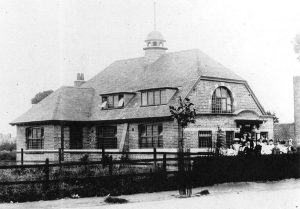
Bradmore Chapel
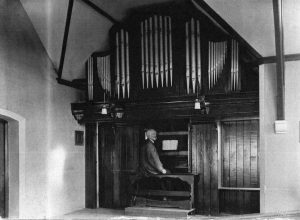
The Bradmore Organ
In 1914 a school hall was erected behind the Bradmore chapel at a cost of £235, Mr Davis Green financing the cost of furnishing the new premises.
A New Church is Planned
The seeds for the building of the Beckminster church itself can be said to have been planted when in 1921 the Rev’d Fred W Townsend was appointed to have special oversight of the Penn Road and Bradmore chapels.
At a meeting of the Bradmore Trustees held on 23rd June that year, two letters were read out; jointly they would have a profound effect. The first was from the Wolverhampton Borough Engineer who wanted to take a strip of land from the ground surrounding the chapel for road improvement. The second letter, written after a Leaders’ meeting conveyed the following resolution:
“that the Leaders’ Meeting feel that the spiritual life of the Church is seriously hindered by the lack of suitable accommodation, and the Leaders beg of the Trustees to take immediate practical steps to meet the demand.”
Now on one hand the Trustees had the Borough Council wanting to reduce the size of their land and on the other hand, the leadership team wanting immediate enlarged premises. Clearly the two requirements were incompatible and bearing in mind the development of the Birches Barn council housing estate on their doorstep, a move to new premises seemed unavoidable.
Someone suggested that a site between the Penn Road chapel and Bradmore, with a union between the two societies, would be the ideal solution and when in 1923 a vote was taken at a Circuit meeting only two votes were cast against the resolution. This decision however brought further difficulties to Penn Road, many of the old stalwarts felt that they had been let down and quite a number left, leaving it only a shadow of its former self. The few who remained carried on in Church and Sunday school and would eventually take their places in the new church. Now over 40 years old and in urgent need of considerable renovation the Penn Road chapel was faced with a much reduced congregation. The Great War of 1914 – 1918 denuded the Penn Road chapel of most of its young men, eight of whom were killed, and of the 80 or so that came back from the fighting very few returned to worship at the Church.
The End of the Penn Road Chapel
The minutes of the final meeting of the Trustees of the Penn Road Chapel, held at 6.30 p.m. on 22nd October 1925 make for sad reading;
Present: Rev. H.M. Nield in the Chair
Supported by Rev. E. Dennis
Also present: Messers Hubert Thomas, Davis Green, A. Tilsley, Walton, Hough, Haynes, Timbrell, Baker, C. Wells & the Secretary (G.H. Wells).The minutes of the meeting held on 5th June were read and confirmed.
| The late Mr W. Bayliss, Senior Trustee | The Chairman next referred to the death of Mr William Bayliss – the Senior Trustee of Penn Road and instanced his long and valuable services to the cause at Penn Road, and that he had given thoughtful consideration to the present situation of the state of the finances and lack of congregation at Penn Road, – up to a week before his death at the age of 85. A resolution of sympathy & condolences with the relatives, and of thankfulness for the services rendered to the Church by the deceased gentleman during his lifetime was unanimously passed by all standing. |
|
| Report from Quarterly Meeting | The chairman reported that the resolutions passed by the Trustees of Penn Road at their meeting held on 5th June had been fully considered. A resolution was passed by the Quarterly Meeting (which was held at Trinity on 16th June) that there was no alternative to the closing of Penn Road and the transference of the Work to Beckminster. No overcrowding of the Bradmore Sunday school would take place when the scholars from Penn Road had been distributed, as was arranged between Darlington Street, Beckminster and Poultney Street. The Chairman had put the matter before the Chapel Committee, all of whom concurred with the attitude taken by the Quarterly meeting. |
|
| Trust A/c | Mr C. Wells, Treasurer, – on reply to a question as to the state of the Trust account – estimated that the deficiency would be £95 to £100 at the end of the year. | |
| Policy of the Circuit Work | Mr Davis Green then referred to the policy of the transference of the Work at Bradmore and Penn Road to Beckminster new Church and moved a resolution that Penn Road Chapel be closed, seconded by Mr Charles Wells, – Mr Tilsley said there was little need of discussion on the Resolution now, considering that the matter had been so fully gone into from every point of view; also that the former congregation which had attended Penn Road Chapel was not drawn from the neighbourhood of the chapel – the Resolution was then put. 8 voted for, 1 against, 1 abstained. | |
| Disposal of Scholars | Mr Haynes raised the question of the transference of the whole of the scholars to Beckminster & their amalgamation with Bradmore School. Rev. E. Dennis stated in reply, on behalf of the Penn Road School Council that they would be responsible for the transfer of the whole of the scolars & that they would be allocated according as their homes were situated, to the most convenient church, mainly Darlington St., Beckminster & Poutney St. (Mr Whitlock of Trinity Chapel had kindly offered to entertain the two schools when the transfer was completed). | |
| Arrangements for Transfer of Effects | A Sub-Committee was appointed as follows: Mr Hough, Mr Tilsley, Mr Timbrell, Mr C. Wells & the secretary (G.H. Wells) to collaborate with the Trustees of Beckminster for the transfer of the furniture and effects of Penn Road to the new church & schools at Beckminster. Mr Tilsley proposed and Mr Davis Green seconded that all the furniture at Penn Rd should be available for the Beckminster Trustees, providing that the same was not removed so long as required by the Society or Sunday School at Penn Road. |
|
| Tablets & Memorials | Mr Tilsley proposed & Mr Walton seconded that all tablets and memorials of Penn Road should be placed in suitable positions in the lobbies and corridors of the new church at Beckminster. | |
| Disposal of Trust Liabilities | It was resolved that the Liabilities of the Penn Road Trust should be handed over to the Beckminster Extension Committee. | |
| Disposal of Premises | Mr H. Thomas proposed & Mr Davis Green seconded that instructions for the sale of the land & premises should be given to Messers A.B. & A. Annan Auctioneers; a stipulation to be made that the premises shall not be used for the sale of intoxication liquors for a period of 50 years from the date of sale. The resolution was passed unanimously. | |
| Proceeds of Sale | A rider was added that the proceeds of the sale shall be paid into the funds of the Beckminster Extension Scheme for the erection of houses for the Minister and Caretaker of the new Church. | |
| Date Continuance of School | It was resolved that the Sunday School at Penn Rd shall continue to be held until the 31st of Dec. 1925. |
Building Beckminster
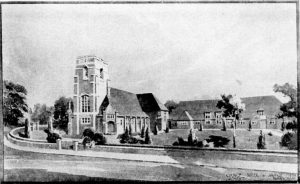
Artists impression of the new buildings
In the early 1920’s schools were using the site on which the new church would be located as a playing field, St. Phillip’s Avenue was still a cornfield.
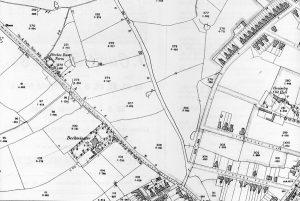
Another 1903 map showing location of site
Raising Funds
Right at the beginning a Building Fund was opened, Mr Davis Green, who had been instrumental in establishing the chapel at Bradmore, was appointed treasurer with the other Churches in the Circuit joining in. The Sunday school children sold paper bricks at 2d (0.83p) each, if they sold 5 shillings (25p) worth they became entitled to lay a brick at the stone laying ceremonies of both the school hall and church. Sales of work were held, supper parties in friends homes and concert parties all took place. People made marmalade, cakes, sweets, toffee, and pickles, which they sold, to neighbours and friends. There was even an attempt to lay a ‘mile of pennies’ from the building site along Birches Barn Road and Stubbs Road and passers-by were asked to contribute a few coins to the line along the curbs at the sides of the footpaths.
A two-day Garden Party was held at Ash Hill, the home of Mr and Mrs Davis Green and although it rained heavily on the first day, a fine Saturday ensured that it was a financial success.
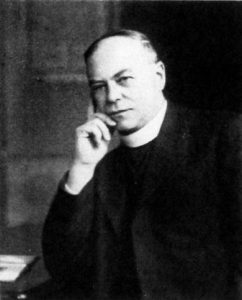
Revd. Ernest Dennis
Rev. Ernest Dennis, Minister 1925 – 1928
The Rev. Ernest Dennis oversaw the merger of the two Churches
London (Brixton Hill) 1906 – 1910; Sunderland (St. John’s) 1910 – 1914.
When, in 1925, the Rev. Ernest Dennis took over from the Rev. Townsend, all of the arrangements for the new church at Beckminster were in place, a plot of land in an excellent position at the junction of Birches Barn Road and the newly built but undeveloped St. Phillip’s Avenue, both positioned for serving the rapidly developing housing in the area as well as the established area of Penn Fields, was purchased from the Beckminster Estate. The location had the added benefit of being almost equidistant between the two founding Churches. The Birmingham architects Crouch, Butler, and Savage (Chief Architect Mr Moss) who had previously designed Methodist churches across the Midlands were instructed to submit plans for a church to seat approximately 600, together with a Sunday School, Manse and Caretaker’s house, and the building firm Swift, also of Birmingham were engaged to undertake the work at an estimated cost of £16,000.
Laying the Foundations
The stone laying ceremony for the schoolroom was held on 21st May 1925 and for the church on 9th July of that year. The Express and Star reported the ceremony and relates that four foundation stones were laid on that day. Two of the foundation stones from the old Penn Road Chapel, originally laid by The Samuel Dickinson Esq. Mayor of Wolverhampton and Alderman Jenks on 12th March 1877 were also incorporated in the new building.
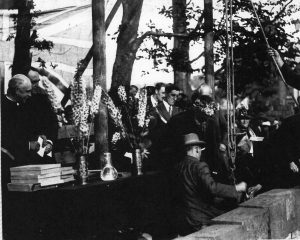
Stone laying ceremony 9th July 1925
Building the Church
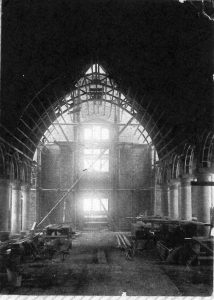
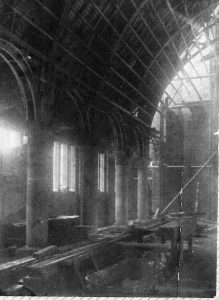
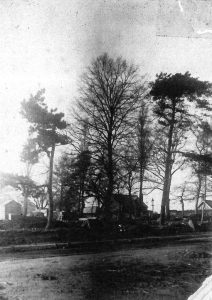
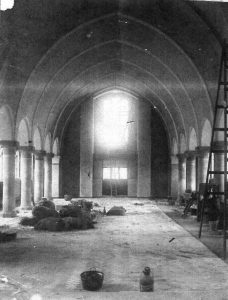
The first part of the building work to be finished was the Sunday school and the ‘Beckminster Wesleyan School’ was opened on 3rd December 1925. Initial Services were held there from that date, the Penn Road and Bradmore Societies officially joining as one under the ministry of the Rev. Ernest Dennis. Now more ambitious fund raising events could be held; including concerts and banquets with guest speakers, there was even a performance of Gounod’s ‘Faust’ on the schoolroom stage.
The church building was opened on 10th June 1926 and the first sermon preached by the Rev’d T. Dinsdale Young a gifted preacher, lecturer, administrator and writer, he was a renowned figure in Methodism, preaching from the pulpit in Wesley’s Chapel, London for 8 years before moving in 1914 to Central Hall, Westminster. Said to be an apostle-like figure, white- haired with a fine voice, which would rise, and fall abruptly to emphasize a point. One oft-repeated action would come at the climatic end of his sermon. He would sharply close the large bible on the lectern with a resounding crack, and then waiting a second or so, would break the startled silence with “Now let us pray.” In the unlikely event of a worshipper having dozed off during the sermon they could not fail to return to earth at the loud snap of the closing book.
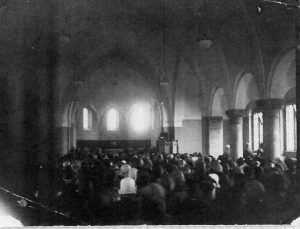
The first service
The First Service
The first Service at the new Church must brought mixed feelings to the congregation with so many memories of their old Churches but those would have been tempered by the exciting opportunities which lay ahead. It seems that, initially at least, the two original congregations preferred to sit apart from each other, the former Penn Road members sitting on the left of the new church, the Bradmore members on the right. This state of affairs seems to have persisted for some time until new members joined the Church and the line of demarcation became less clear.
All Debts Discharged
A final fund raising event took place in November 1927 when ‘An Olde English Fayre’ was held. The school hall was set out as an old village street with stalls inside the shops. The target was £1,000, a substantial amount in the days when a three-bedroomed house cost £600 – £700.
In those days church bazaars went on until the late evening. Everyone was feeling very tired. At 10 p.m. the Rev’d Dennis mounted the platform to announce that £1037.8s. 4d had been raised. The target had been reached, but then came another challenge. To quote from the Beckminster Bazaar Bulletin; “The final appeal was one of the most exciting incidents in bazaar history. £90 odd was needed to clear off the debt – so Mr Davis Green made a sporting offer. He would give £50 if the odd £40 could be collected at the bazaar that night. Immediately cries of £5, £4, £3, etc., were heard and in about 5 minutes Mr Wright announced that the required amount had been raised, and so ended the most remarkable and wonderful bazaar that has ever been held”.
The new Church was free of debt.

